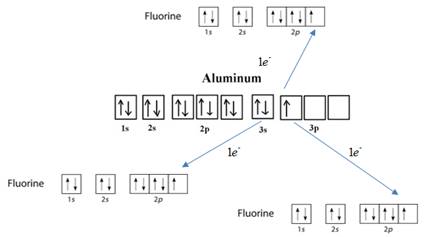
Concept explainers
Interpretation:
The ionic bond formed between Aluminum and fluorine needs to be explained using orbital diagrams.
Concept introduction:
Molecules are bound together by different types of bonds namely ionic and covalent. Ionic bonds are formed when there is complete transfer of electrons from one atom to another. These atoms either lose or gain electrons to become negatively or positively charged ions. The forces of attraction between these ions cause the ionic bond formation.
Orbital notations are marked using boxes and arrow marks to represent the arrangement of all electrons.
Answer to Problem 70A
The aluminum will form
Explanation of Solution
Ionic bonds involve the transfer of electrons from one atom to the other. The metal atoms, an electrons donor, loses electrons to form a positively charged ion while the non-metal atoms, electron acceptor, gains electrons to form negatively charged ions. During the process of donating or gaining electrons, the atoms follow octet rule to attain a stable noble gas configuration.
Aluminum has
Fluorine has atomic number as 9 with electronic configuration as
The orbital notation for aluminum and Fluorine is given below. As aluminum can give up 3 electrons, and Fluorine is in need of only one electron, 3 electrons of Aluminum will donate to 3 fluorine atoms.

The aluminum will form
Chapter 7 Solutions
Chemistry: Matter and Change
Additional Science Textbook Solutions
General Chemistry: Principles and Modern Applications (11th Edition)
Chemistry: A Molecular Approach
Introductory Chemistry (6th Edition)
Chemistry: The Central Science (13th Edition)
Chemistry: A Molecular Approach (4th Edition)
 ChemistryChemistryISBN:9781305957404Author:Steven S. Zumdahl, Susan A. Zumdahl, Donald J. DeCostePublisher:Cengage Learning
ChemistryChemistryISBN:9781305957404Author:Steven S. Zumdahl, Susan A. Zumdahl, Donald J. DeCostePublisher:Cengage Learning ChemistryChemistryISBN:9781259911156Author:Raymond Chang Dr., Jason Overby ProfessorPublisher:McGraw-Hill Education
ChemistryChemistryISBN:9781259911156Author:Raymond Chang Dr., Jason Overby ProfessorPublisher:McGraw-Hill Education Principles of Instrumental AnalysisChemistryISBN:9781305577213Author:Douglas A. Skoog, F. James Holler, Stanley R. CrouchPublisher:Cengage Learning
Principles of Instrumental AnalysisChemistryISBN:9781305577213Author:Douglas A. Skoog, F. James Holler, Stanley R. CrouchPublisher:Cengage Learning Organic ChemistryChemistryISBN:9780078021558Author:Janice Gorzynski Smith Dr.Publisher:McGraw-Hill Education
Organic ChemistryChemistryISBN:9780078021558Author:Janice Gorzynski Smith Dr.Publisher:McGraw-Hill Education Chemistry: Principles and ReactionsChemistryISBN:9781305079373Author:William L. Masterton, Cecile N. HurleyPublisher:Cengage Learning
Chemistry: Principles and ReactionsChemistryISBN:9781305079373Author:William L. Masterton, Cecile N. HurleyPublisher:Cengage Learning Elementary Principles of Chemical Processes, Bind...ChemistryISBN:9781118431221Author:Richard M. Felder, Ronald W. Rousseau, Lisa G. BullardPublisher:WILEY
Elementary Principles of Chemical Processes, Bind...ChemistryISBN:9781118431221Author:Richard M. Felder, Ronald W. Rousseau, Lisa G. BullardPublisher:WILEY





